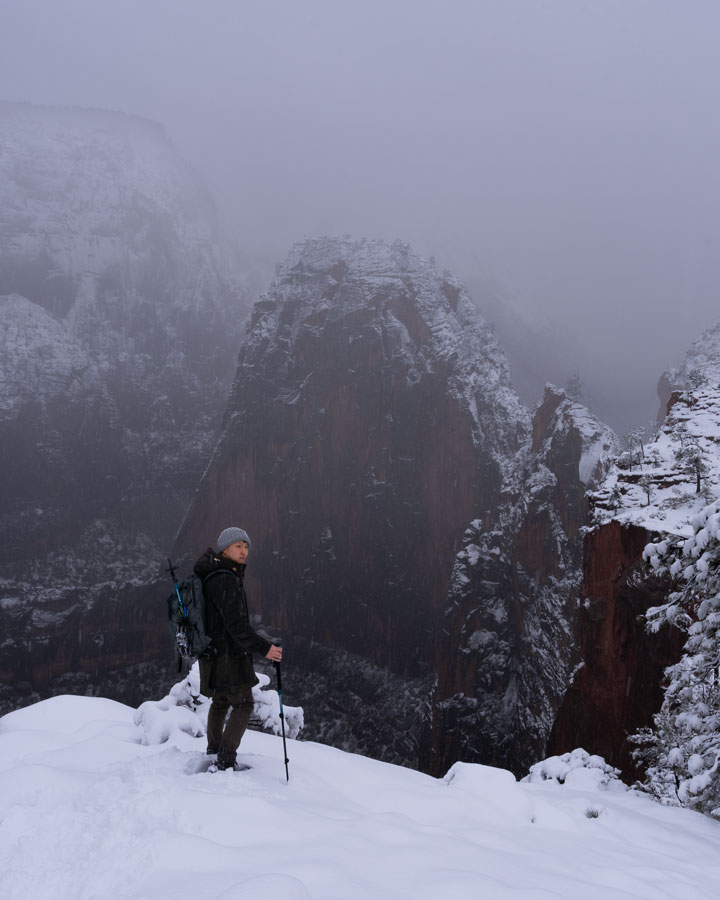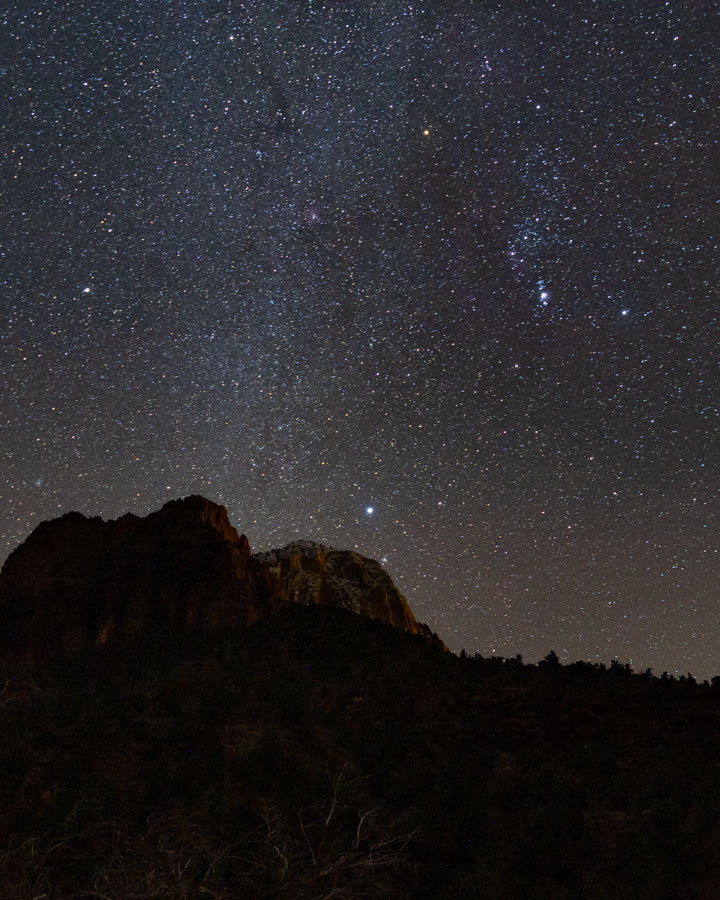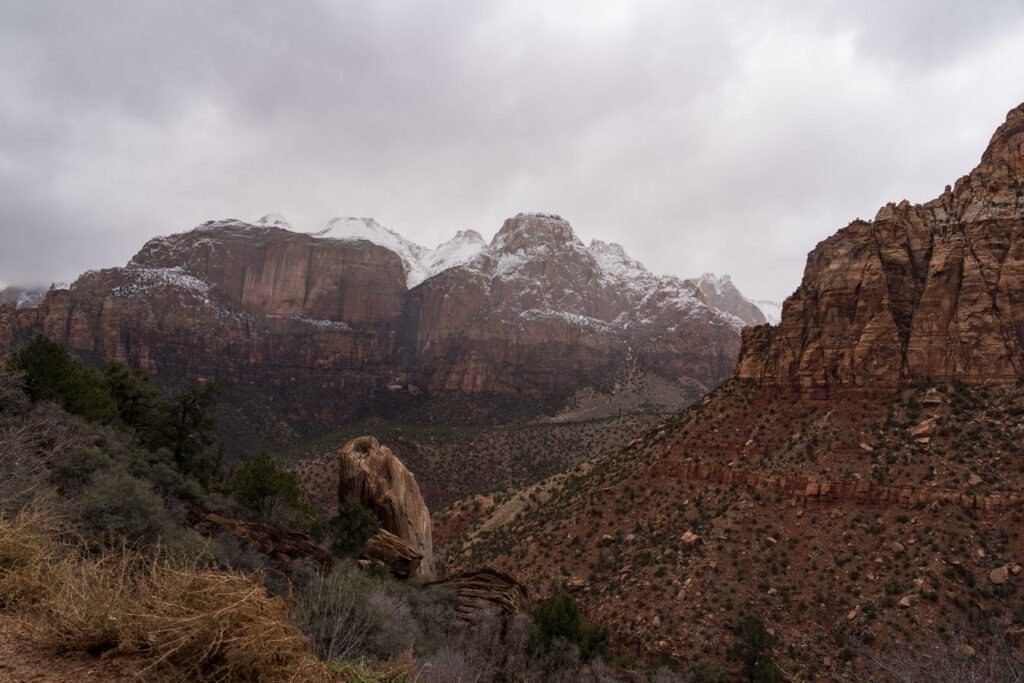Discover the best spots for capturing breathtaking star photography in Zion National Park during the serene winter months. From iconic landmarks like The Watchman to hidden gems along Kolob Terrace Road, this guide will help you find perfect locations for shooting the night sky. Read on to learn how Zion transforms into a peaceful winter wonderland, offering unforgettable astrophotography opportunities.
Introduction: Zion National Park’s Winter Magic
Zion National Park has always been one of my favorite places to visit, and there’s something truly magical about it in the winter. Known for its towering red sandstone cliffs and dramatic landscapes, Zion becomes a peaceful, almost otherworldly destination when the temperatures drop. The usual crowds disappear, leaving the park quieter, while a light dusting of snow transforms the scenery into a winter wonderland. For photographers like me, this quieter season offers an incredible opportunity to capture the stars like never before. With the crisp winter air and clear night skies, Zion’s dark skies become the perfect backdrop for stunning astrophotography. If you’re a photographer looking to capture breathtaking star photography in one of America’s most iconic national parks, winter in Zion is an absolute must.
Left: The view of Angels Landing while snowshoeing on the West Rim Trail during a snowstorm; Right: Snowy peaks of Zion mid-winter viewed from the top of Angels Landing.
Winter Accessibility in Zion National Park: Explore Without the Crowds
One of the major advantages of visiting Zion National Park in the winter is improved accessibility. During the peak season, the Zion Canyon Scenic Drive is closed to private vehicles (during shuttle operating hours) and only accessible via park shuttles. However, in the off-season, including the winter months, visitors can drive their own vehicles through the scenic routes, allowing for greater flexibility and exploration. Even when shuttles are in operation, you can still drive on the Zion-Mt. Carmel Highway, which connects State Route 9 through the park, as well as the Zion-Mt. Carmel Tunnel, Kolob Terrace Road, and Kolob Canyons Scenic Drive. Typically, shuttles run daily from March to November and briefly during the holiday season in late December. After December, shuttle service pauses, offering even more solitude and convenience for winter visitors.
Why Zion National Park is Ideal for Winter Astrophotography
Zion National Park is a gem for stargazers and astrophotographers alike. Thanks to its low light pollution, Zion offers some of the darkest skies in the Southwest, which is critical for capturing clear, bright stars. According to the Bortle scale—a measure of light pollution—Zion National Park ranks between a 2 and 3, making it an excellent location for stargazing. The cold, crisp winter air further enhances visibility, providing the perfect conditions for capturing the Milky Way, star trails, or deep-sky objects with incredible clarity.
Left: Winter Milky Way over Bridge Mountain taken from Mount-Carmel Highway; Right: The night sky over the Sentinel taken from Mount-Carmel Highway.
Essential Gear for Winter Night Sky Photography
To capture breathtaking star photography in Zion during winter, having the right equipment is not necessary but it helps. Particularly, to stay warm while you’re out shooting in the cold night air! Of course it’s necessary to bring a sturdy tripod for long exposure shots, a wide-angle lens to capture the vast night sky, and a remote shutter release to reduce camera shake. Additionally, dress warmly and pack gear to protect your camera from the cold. A weather-sealed camera body is ideal, and extra batteries are a must, as the cold can drain power quickly. Don’t forget lens cloths for clearing condensation or frost from your gear!
Some of the gear I used to capture the astrophotography featured on this post:
- Camera Body: Alpha a7 IV Full-Frame Mirrorless Camera Body
- Peak Design Carbon Fiber Travel Tripod
- Sony FE 24mm F1.4 G-Master – Prime Lens
- Sony FE 16-35mm f/2.8 G-Master II – Zoom Lens
The links above are affiliate links with Shop Moment, which help to support this free blog content through a small sales commission. Thank you for your support!
How to Plan Your Winter Astrophotography Shoot
Planning is key to a successful astrophotography shoot in Zion during winter. Check the weather forecast in advance to ensure clear skies and cold but manageable conditions. Timing your visit with a new moon is crucial to maximize visibility of the stars. Apps like PhotoPills and Stellarium are indispensable for planning your compositions, as they allow you to visualize where the Milky Way and other celestial objects will be positioned at specific times. Scout your locations during the day to familiarize yourself with the terrain before heading out after dark.
The view of the Bee Hive and The Sentinel during the day and night taken from Mount-Carmel Highway.
Camera Settings for Star Photography in Zion’s Winter Skies
For capturing the stars over Zion’s winter skies, start with these basic camera settings: ISO 1600 to 3200, with ideally an aperture of f/2.8 or wider, and a shutter speed of 15-30 seconds (depending on focal length). These settings will help you capture the brightness of the stars without introducing too much noise or motion blur. Manually set your focus to infinity and be prepared to tweak your settings as needed depending on the ambient light and weather conditions. If you’re shooting star trails, try a longer exposure of several minutes to capture the movement of the stars across the sky.
Check out my Astrophotography Beginners Guide here for more information on settings and general tips and guidelines.
Top Locations for Stunning Astrophotography in Zion National Park
When planning your winter photography trip to Zion National Park, choosing the perfect location can make all the difference in capturing breathtaking night sky shots. Zion offers a variety of iconic and hidden gems for photographers looking to frame the stars in this stunning landscape. Here are the top locations for astrophotography in Zion National Park:
- The Watchman
The Watchman is one of the most recognizable landmarks in Zion, and it’s a dream for night photographers. Positioned along the Virgin River, this spot allows you to capture beautiful reflections of the stars in the water. During winter, the snow-dusted peaks and peaceful atmosphere create an ideal backdrop for astrophotography. - Zion Canyon Overlook
Zion Canyon Overlook offers a panoramic view of the canyon, perfect for wide-angle shots of the night sky. The short, accessible hike to this viewpoint makes it an excellent option for astrophotographers. With clear winter skies, you can capture the stars stretching across Zion’s rugged terrain.
The stars over the valley as seen from Zion Canyon Trail
- Court of the Patriarchs
The towering rock formations at the Court of the Patriarchs provide a stunning contrast against the night sky. This location offers unique opportunities to photograph the stars above the massive sandstone cliffs, creating a dramatic foreground. - Kolob Terrace Road
For a quieter, more secluded location, Kolob Terrace Road is an excellent choice. Far from the crowds, this area offers pristine night sky views with minimal light pollution. The road meanders through beautiful red cliffs, giving you plenty of options for compositions under the stars.
The setting sun over canyons seen from Kolob Terrace Road – a potential option for a beautiful foreground for the night sky.
- Zion-Mt. Carmel Highway
The Zion-Mt. Carmel Highway provides several scenic pull-offs for capturing stunning night sky photos. The highway itself, including the famous Zion-Mt. Carmel Tunnel, can serve as a striking foreground element for your astrophotography. Winter offers an especially serene atmosphere for shooting along this scenic road.
The winter Milky Way over the Bee Hive and The Sentinel taken from Mount-Carmel Highway.
These locations offer the perfect combination of iconic landscapes and pristine skies, making Zion National Park one of the best places for winter astrophotography. Whether you’re photographing the towering cliffs, snow-covered peaks, or starry reflections, these spots will help you capture unforgettable night sky images.
Why Winter Stargazing in Zion Should Be on Your Photography Bucket List
Winter stargazing in Zion National Park is an unforgettable experience. The combination of clear skies, minimal light pollution, and stunning foregrounds make this park a must-visit destination for astrophotographers. Whether you’re capturing star trails or shooting the Milky Way, the peaceful solitude of winter allows you to connect with nature in a way that’s impossible during busier seasons. If you’re looking to expand your astrophotography portfolio, Zion in winter should be at the top of your list.
Have you had the chance to photograph Zion National Park during winter? Share your experiences in the comments below! If you’re planning a trip and have any questions about astrophotography, feel free to ask. For more photography tips and guides, follow me on Instagram and Youtube to stay updated on my latest adventures.















